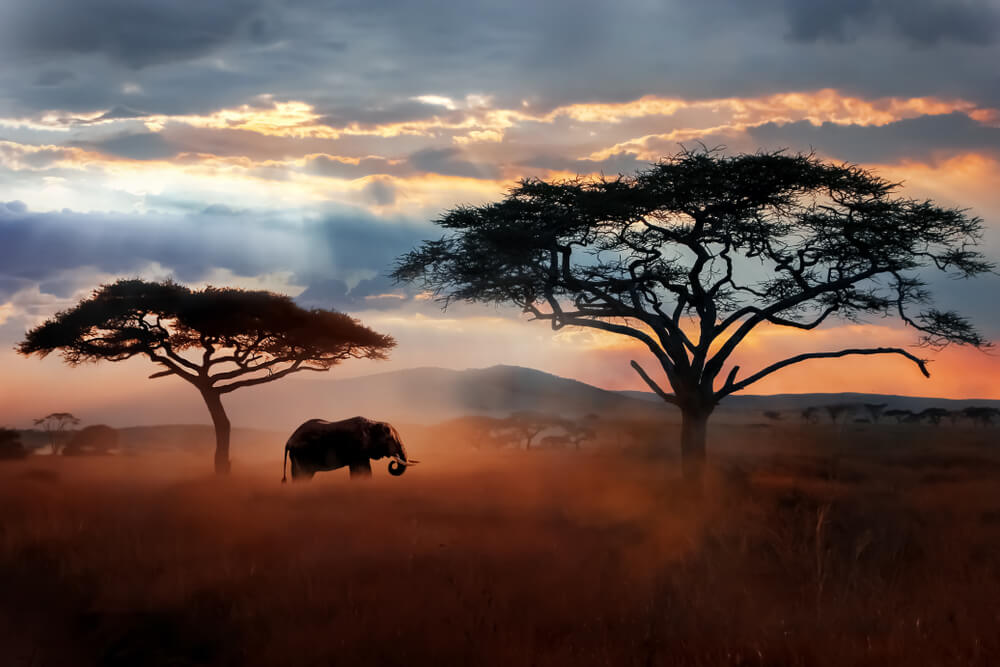When it comes to game hunting safaris, international game hunting enthusiasts generally focus on either the destination or the species. Will they be able to hunt animal X in South Africa, or is it only available to hunt in Namibia? Which destination offers them the most in terms of variety of species, good packages, deals, and activities for the non-hunting members of the family? Not many focus on when the animal will be hunted or which animals provide a great nocturnal hunting adventure!
Nocturnal African hunts are those that focus on hunting at night. This simply put the hunter in the position of being active and awake when his prey is. Just as some animals prefer to hunt at night, as this is when their prey is awake and foraging for food and water, so game hunting safaris have certain target species that are best hunted at night. Some examples include hyenas, members of the cat family, as well as the porcupine and honey badger.

[DYNAMIC-BLOGTABLEOFCONTENT]
Do All African Countries Allow Night Hunting When on a Game Hunting Safari?
No, not all countries allow hunting at night. Some countries do not allow any type of hunting activities at night of any species whatsoever, while others allow only certain species to be hunted.
Each country has its own set of rules and regulations, as well as permits that may be required.
Is hunting allowed at night in:
South Africa – Yes
Zimbabwe – Yes
Botswana – Yes
Mozambique – Yes, but when hunting lion, bushpig, leopard, and crocodile.
Zambia – No, no hunting may take place at night or under artificial lights.
Tanzania – No, no hunting may take place at night or under artificial lights.
Namibia – No, no hunting may take place at night or under artificial lights.
Can I Include a Night Hunt on My African Hunting Safari Package?
Depending on the species targeted, for example, the leopard, it may automatically be included, as leopards are active at night and are actively hunted when the sun goes down. In this case, you will probably be allowed to add more African plains game to your African hunt, allowing you to hunt magnificent animals during the day since your main trophy hunt takes place mostly at night. You will need to confirm with your hunting outfitter as to extra charges.
Other species, for example, the springhaas (South African springhare), are included as more of a hunting adventure while out on a night drive, as they are an opportunistic game hunting species. A side note here is that the South African springhare is not a hare at all, but rather a medium-sized burrowing rodent!
What Species Are Generally Hunted at Night During an African Hunt?
Depending on where you are in Africa, if hunting is allowed at night, and which species may be targeted, there are numerous animal species that can be hunted during a nocturnal hunting adventure.
The Spotted Hyena
The spotted hyena is renowned for its laugh. This laugh, sounds almost like a witch’s cackle from a children’s fairytale! It is a sound that you will instantly recognise while on your African hunt. Apart from South Africa’s hadada, this must be one of the most infamous sounds on a game hunting safari.
The spotted hyena is the largest of the hyena clan and it is usually hunted through baiting and stalking.
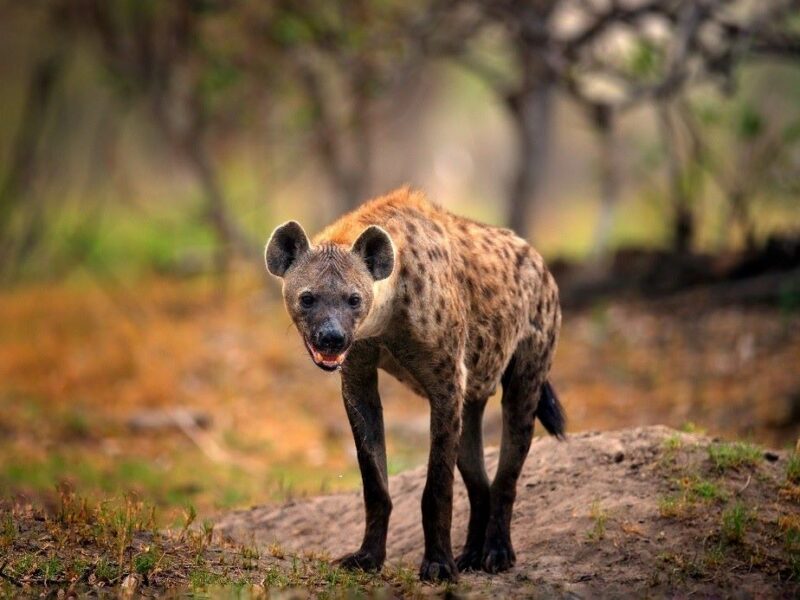
The Brown Hyena
Brown hyenas are omnivores, feeding on a variety of fruit, eggs, birds, and insects, but they are also major scavengers, hoping for leftovers from lions, cheetahs, and other large prey. They tend to rest during the day while it is hot and are more active at night when the heat subsides.
They are hunted in three main ways on African hunts:
- With a spotlight or artificial lights
- From a blind
- Walking and stalking
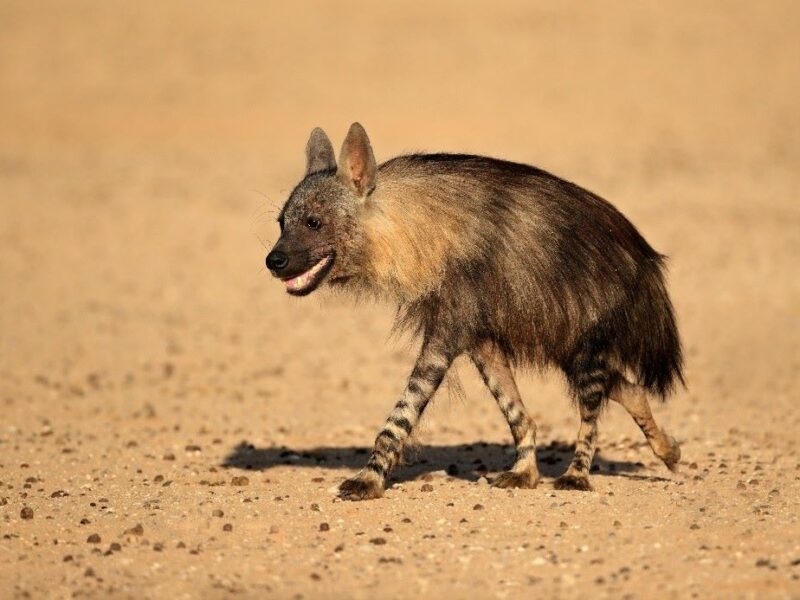
The African Lion
Africa’s king of the jungle, as he is known (even though he doesn’t live in the jungle but in the African bushveld!), is the African lion. This beast of an apex predator reaches weights of up to 570 pounds of pure muscle, and, it is not to be messed with! It is also seen as quite a crafty or cunning animal, often circling the hunter so that they, in turn, become the prey!
Lion hunting methods on an African hunt include baiting and tracking.
The Leopard
The leopard is a highly intelligent, elusive, cunning, and shy member of the Cat family. This magnificent animal is a firm favorite with international game hunting enthusiasts and makes the most beautiful game hunting trophy.
Being nocturnal, they rest during the day and do most of their hunting at night, feasting on various foods, including fish, reptiles, warthogs, and numerous antelope species. They are extremely proficient climbers and are known for hiding their prey high up in trees, away from other predators who may be looking for an easy meal option.
Leopards are generally hunted using stalking, baiting, or hounds, depending on where the hunt takes place and the local area’s laws and regulations relating to leopard hunting.
Many African hunts targeting leopards have ticked all the boxes and vigorously prepared for this predator hunt, only for the hunter to be unsuccessful. Again, I stress that leopards are highly intelligent and it is not unheard of for a leopard to visit a baiting station successfully for weeks prior to the hunt as the outfitter sets the trap, only to be spooked by something within days of the hunt, or during the hunt – never to return to the spot again.
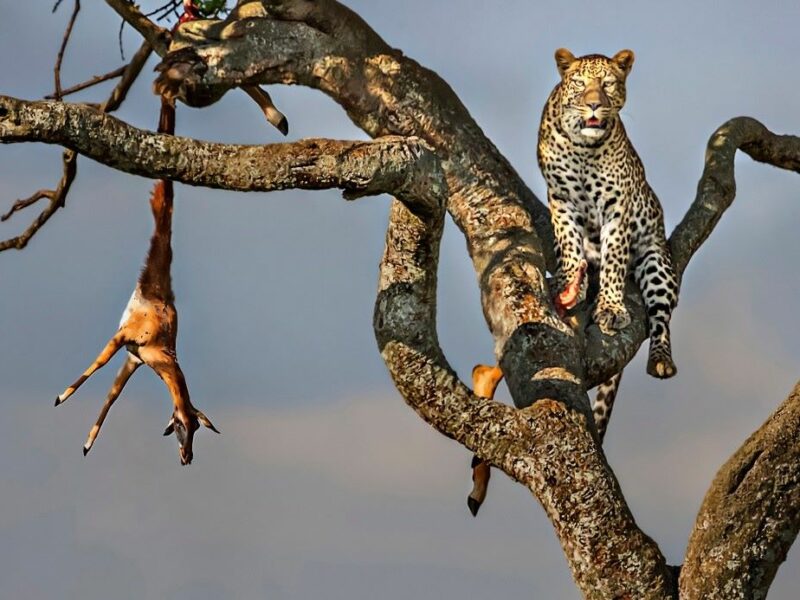
The Caracal
This powerful cat is going to be a chance target, an opportunistic hunt if ever there were one. On your game hunting safari, keep a lookout for a medium-sized cat weighing around 15-40 pounds, with long legs, short tail, and pointed ears sporting long tufts of fur. Although mainly nocturnal, the caracal, also known in South Africa as a “rooikat” (red cat), will venture out during cloudy or overcast weather.
This cat is extremely agile and has the amazing ability of being able to leap straight up into the air, reaching a height of up to 10 feet! This comes in incredibly handy for this predator who has a taste for featured friends, monkeys, snakes, and insects.
Hunting methods employed on an African hunt to target the caracal include spotlights with bait to encourage them to within closer range, while you wait within the blind to take the shot. In South Africa’s Eastern Province, as well as KwaZulu-Natal, hunting with hounds is also legal while some hunters prefer to utilise predator calls to get the animal to show itself.
The Civet
The civet is a small, cat-like, solitary creature that weighs between 22-33 pounds. It is extremely agile and spends much of its time resting and sleeping in trees.
Civets are nocturnal and they are most active for about an hour after dark as they hunt. They enjoy an omnivorous diet that includes crabs, rodents, reptiles, fruits, birds, eggs, and insects. Civet hunting in Africa is usually part of a specialist game hunting safari, with the walk and stalk or spotlight hunting methods employed.
Nothing is quite as exciting as a night-hunting adventure under African skies! Spotlights target the animal, allowing for an exhilarating hunting safari as hunters search for this elusive animal.
African Genets
The African genet is a nocturnal, solitary animal who prefers to sleep and rest during the day and is most active just after sunset and before sunrise. They are creatures of routine and tend to rest and sleep in the same trees, caves, or thicket areas, allowing those tracking them an easier spot and stalk game hunting safari. They are hunted with a spotlight and are very quick, nimble and camouflage themselves extremely well, making them a great challenge for a nocturnal African hunt!
The African genet is an omnivore, feeding on a variety of foods including eggs, birds, fruits, and insects. They are quite small cats, with adults weighing around 6.5 pounds, but are extremely agile and often take refuge in trees, so keep your eyes peeled when hunting this game hunting trophy.
Aardwolf
The aardwolf is a nocturnal, solitary creature who spends its days resting in burrows and emerging at night to forage. They are extremely difficult to spot or hunt but are hunted using spotlights.
They are found in Southern and East Africa and sport a yellowish tail with vertical black stripes. It also has an extremely busy tail. They are shy, elusive, secretive animals and are rarely encountered, making them even more of a challenge on this hunting adventure!
When targeting an aardwolf on your African hunt and it takes place in South Africa, the Eastern Cape and Free State provinces are known for their aardwolf success.
Note that aardwolves are protected, and hunting legislation differs from area to area. Permits are available to hunt them, with prior approval.
South African Springhare
I think that the South African springhaas (springhare) is probably one of the most fun and exciting night hunts that you will ever enjoy! As mentioned previously, the springhare is actually not a hare or rabbit, but rather a member of the rodent family.
They are nocturnal and emerge at night to forage for fruit, plants, and herbs. Springhares travel great distances each night in search of both food and water. They have the amazing ability to jump up to 6 feet at a time, allowing them a great getaway tool from predators that include birds of prey, cheetahs, and other members of the cat family.
Once again, they are hunted at night with spotlights. A PH I know once told me, “If you are out on a night hunting safari, and all you see is an eye that seems to be hopping, then you know you’ve got a springhare!” Sound advice if ever there was!
Bushpig
Bushpigs live in family groups, but large males may also live solitary lives. They are nocturnal omnivores, preferring to rest and sleep during the day before appearing at night to forage for food. They are known scavengers but also eat insects, plant roots, fruits, and crops – a reason why they are seen as pests and targeted on a nocturnal African hunt!
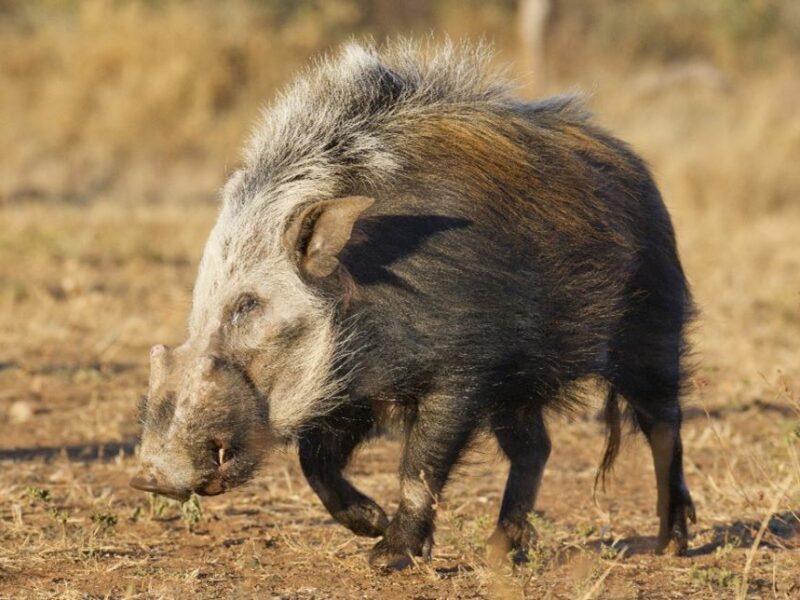
Cape Fox
The Cape fox is a nocturnal hunter who prefers the cooler night weather for its hunting activities. They are known as omnivorous and opportunistic hunters, and feed on small mammals, reptiles, and insects, but will also include carrion and fruit in their diet.
Cape foxes are hunted as a specialty species or a trophy of opportunity, many times on night African hunts. They require a Threatened or Protected Species (TOPS) hunting permit to be hunted in South Africa. Most hunting for Cape foxes is undertaken at night, making it an exciting game hunting adventure for the hunting party!
Four methods are generally employed for Cape fox hunting, including opportunistic hunting, spotlights, predator calls, and tracking and stalking.
Porcupine
Found in sub-Saharan and northern Africa, the porcupine is seen by many farmers as a pest, since they destroy and eat crops. With this species being more active at night, they are targeted on night hunts, mainly being an opportunistic hunting opportunity.
Tipping the scale at about 20-60 pounds, they are primarily herbivores, feeding on a range of bulbs, roots, leaves, berries, and fruits, but have been known to indulge in or gnaw on carrion.
Honey Badger
If I am honest, I must admit that honey badgers are definitely one of my favorite animals of all time. A vicious, plucky, fearless, tough, no-nonsense creature that takes on a snake without a second thought, yes, that deserves a gold star in my book! These omnivores are renowned for their bad attitude and are not to be messed with!
When honey badger hunting at night in South Africa, a special prearranged permit, as well as a Threatened or Protected Species (TOPS) permit, is needed. These need to be obtained before the game hunting safari. They are usually hunted using bait, with the hunter waiting for the animal to appear.
Be warned, you do not want to mess with a honey badger, be sure to get that shot placement correct!
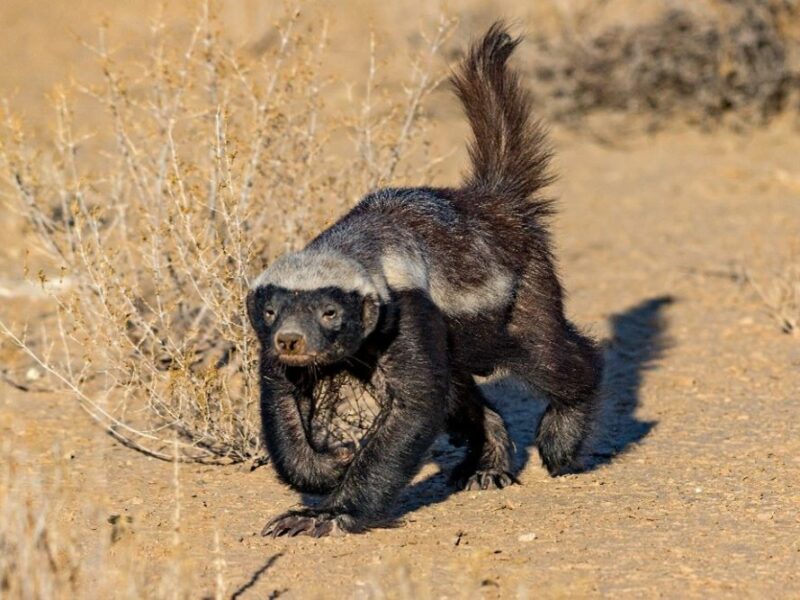
Night Hunting in Africa
Night hunting in Africa brings a whole new level of excitement to any African game hunting adventure! The variety of animals targeted, from members of the Big 5 and Dangerous 7, through to specialty species and members of the African cat family, ensures a challenging and exhilarating hunting safari!
Planning a hunting trip to Africa and want to combine a night hunt with your hunting safari package? See more information about dangerous game hunting, African plains game, or specialty animals, depending on your focus.
Author: B. Hershensohnn
